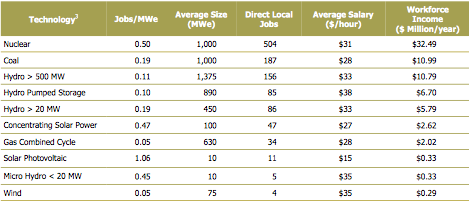Nuclear jobs, jobs, jobs
 As much as I like reading Bill Tucker’s generally pronuclear articles, I recognize that he sometimes gets the details wrong. In a recent American Spectator article titled Nuclear’s Dilemma: Few Jobs, Just Energy, Bill overlooked some important details about nuclear energy’s ability to generate good jobs in comparison to its competitors in wind, solar, coal, oil and gas.
As much as I like reading Bill Tucker’s generally pronuclear articles, I recognize that he sometimes gets the details wrong. In a recent American Spectator article titled Nuclear’s Dilemma: Few Jobs, Just Energy, Bill overlooked some important details about nuclear energy’s ability to generate good jobs in comparison to its competitors in wind, solar, coal, oil and gas.This is a subject where I have some personal, direct experience and some industry data worth sharing.
Without getting into too many sensitive corporate or personal information, here is my personal testimony. I retired from the US Navy after 33 years of service – including my time at the Naval Academy and some time in the Naval Reserves – a little less than two years ago. During my transition phase from that job, I attended several seminars and courses about the process of obtaining a civilian job. I had a leg up on my fellow attendees; I had been studying the nuclear industry for several years and had a pretty solid idea what I wanted to do and where I wanted to work.
I might have been overly optimistic about my prospects, but I only sent out one resume. That resume helped me land a job supporting B&W’s category-creating small modular reactor (SMR) – the B&W mPowerTM reactor. I started my civilian career almost exactly two years ago. The project had started just a year or so earlier, beginning with a group of less than 20 people. By the time I arrived, the project head count was above 50; it is now more than 100 in our location plus another 200-300 in other offices.
Something close to 10% of the work force at my location has chosen to live in the same neighborhood where my wife and I purchased our home. All of the houses occupied by B&W mPower, Inc. employees in our neighborhood were built in the past 5 years. The total real estate investment by that small segment of the project group in the local community is probably between $3-4 million. Since arriving in our new home, my wife and I have purchased a couple of cars, a lot of restaurant meals, plenty of groceries, some clothing and a few nice pieces of furniture. We do a pretty fair job of recycling my salary into the local economy.
The jobs that my colleagues and I fill were recently created by visionaries who recognize that there is a huge need for reliable, ultra low emission nuclear energy in the United States. They have stepped out to take a leadership role even though there is a well-organized opposition and a general misunderstanding about the longevity of current natural gas prices.
The group of focused professionals that the leaders have put together has developed a number of technical innovations worthy of patent protection. We are working diligently on the lengthy process required to solidify our design into an attractive product and to apply for permission to build the machines that we are sure will provide valuable service to our customers and our country. Most of the components in our products will be built in North America.
Some people love to criticize nuclear energy because our durable plants are not cheap to build, but they fail to give the technology credit for the destination of the dollars. Nearly all of the money associated with the high initial cost gets distributed into the pockets of the people who are doing the difficult, painstaking work of developing the designs, forming the tight tolerance machinery, pouring the high strength concrete, laying out the reliable electrical power infrastructure, and ensuring that each step is completed and documented accurately.
The people whose salaries are part of the “high cost” of designing and building new nuclear power plants could be your neighbors and may very well be the people sitting at the nearby table at a local restaurant or in the bleachers at a local high school football game or in the desk next to you at the local PTA meeting.
In addition to my personal testimony, here are a few excerpts from the Nuclear Energy Institute publication titled Nuclear Energy’s Economic Benefits – Current and Future.
The nuclear energy industry can play an important role in job creation and economic growth, providing both near- term and lasting employment and economic benefits. The 104 nuclear units in the U.S. generate substantial domestic economic value in electricity sales and revenue – $40-$50 billion each year – with over 100,000 workers contributing to production.
…
Each year, the average 1,000 megawatt (MW) nuclear plant generates approximately $470 million in electricity sales (economic output) in the local community and more than $40 million in total labor income.1 These figures include both direct and secondary effects. The direct effects reflect the plant’s expenditures for goods, services and labor. The secondary effects include subsequent spending attributable to the presence of the plant and its employees as expenditures filter through the local economy (e.g., restaurants and shops buying goods and hiring employees).
…
The average nuclear plant pays about $16 million in state and local taxes annually. These tax dollars benefit schools, roads and other state and local infrastructure. The average nuclear plant also pays federal taxes of $67 million annually.
…
A recent analysis found that nuclear plants create some of the largest economic benefits compared to other electric generating technologies due to their size and the number of workers needed to operate the plants. Operation of a nuclear plant requires 400 to 700 direct permanent jobs. These jobs pay 36 percent more than average salaries in the local area. These opportunities will be available to new workers since 39 percent of the nuclear workforce will be eligible to retire by 2016 (about 25,000 employees).
…
A new nuclear plant represents an investment of $6-8 billion (depending on plant size), including interest during construction. New plant construction creates demand for skilled labor such as welders, pipefitters, masons, carpenters, millwrights, sheet metal workers, electricians, ironworkers, heavy equipment operators and insulators, as well as engineers, project managers and construction supervisors.
In anticipation of new nuclear plant construction, U.S. companies have created in excess of 15,000 new U.S. jobs since 2005. Manufacturing and technical service jobs have been created in Virginia, North and South Carolina, Tennessee, Pennsylvania, Louisiana and Indiana. These jobs include engineering services and the manufacture of components including pumps, valves, piping, tubing, insulation, reactor pressure vessels, pressurizers, heat exchangers and moisture separators.
Construction of a new nuclear power plant requires up to 3,500 workers at peak construction. Construction will also provide a substantial boost to suppliers of commodities like concrete and steel, and manufacturers of hundreds of plant components. A single new nuclear power plant requires approximately 400,000 cubic yards of concrete, 66,000 tons of steel, 44 miles of piping, 300 miles of electric wiring, and 130,000 electrical components.
…
U.S. companies and workers also benefit from the expansion of nuclear energy underway worldwide. American companies have already booked export orders for billions of dollars in equipment and services, including generators, reactor coolant pumps and instrumentation and control systems. U.S. workers in 25 states – including Illinois, Ohio, Pennsylvania, South Carolina, Virginia and Tennessee – are beginning to reap the benefits of reinvestment in the U.S. nuclear supply chain.
According to the Department of Commerce, every $1 billion of exports by U.S. companies represents 5,000 to 10,000 jobs. The four Westinghouse AP1000 projects underway in China support over 15,000 U.S. jobs. The direct jobs generated from these exports had an average salary of $84,000. These jobs include design and engineering, manufacturing, information technology and transportation.
This table from the NEI publication provides some direct comparisons on various measures of effectiveness between nuclear energy and other energy technologies that compete with nuclear for customers and for investment dollars – both private and public.

There are several things about those nuclear jobs that are quite different from the types of jobs created in the fossil fuel extraction industry or the unreliable, weather-dependent energy flow capture industry. Our jobs tend to require hard working, dedicated, high integrity people who do not want to give up their family lives. They tend to concentrate in areas where life is pretty pleasant, with plenty of water resources, and satisfactory local infrastructure. We do not need to go where the oil, coal and gas happens to be. We do not need to build our machinery on vast open deserts, in the frozen Arctic, on mountain ridges or in a challenging off-shore location.
Though it may have once been true, the following statement from Bill’s article would never be made about the currently available jobs in the nuclear industry:
Let it be said first that the other players missing in action here are gas and oil. New drilling techniques for shale gas and tight oil are now creating more jobs and useful energy than all the other technologies combined. Production from the Marcellus Shale in Pennsylvania and Ohio is up 82 percent over last year. North Dakota’s Bakken shale has created the lowest unemployment rate in the nation. Oklahoma gas fields are complaining they can’t find enough workers. Any healthy, working-age male could head for any of these states and find themselves making close to a six-figure income.
There are plenty of jobs in the nuclear energy industry for females, for people with disabilities, for people of advanced age (one of my colleagues at B&W is still going strong in his 80s because he is excited to be designing something completely new) and for people who have never had much desire to relocate to a boom town like Williston, North Dakota to live in a “man camp”.
You can return to the main Market News page, or press the Back button on your browser.

